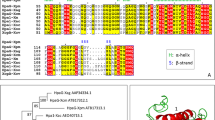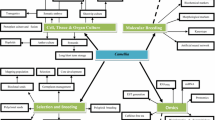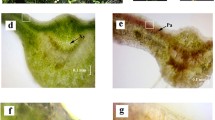Abstract
Harpin proteins from plant pathogenic bacteria can stimulate hypersensitive cell death (HCD), drought tolerance, defence responses against pathogens and insects in plants, as well as enhance plant growth. Recently, we identified nine functional fragments of HpaGXooc, a harpin protein from Xanthomonas oryzae pv. oryzicola, the pathogen that causes bacterial leaf streak in rice. Fragments HpaG1–94, HpaG10–42, and HpaG62–138, which contain the HpaGXooc regions of the amino acid sequence as indicated by the number spans, exceed the parent protein in promoting growth, pathogen defence and HCD in plants. Here we report improved productivity and biochemical properties of green tea (Camellia sinensis) in response to the fragments tested in comparison with HpaGXooc and an inactive protein control. Field tests suggested that the four proteins markedly increased the growth and yield of green tea, and increased the leaf content of tea catechols, a group of compounds that have relevance in the prevention and treatment of human diseases. In particular, HpaG1–94 was more active than HpaGXooc in expediting the growth of juvenile buds and leaves used as green tea material and increased the catechol content of processed teas. When tea shrubs were treated with HpaHXooc and HpaG1–94 compared with a control, green tea yields were over 55% and 39% greater, and leaf catechols were increased by more than 64% and 72%, respectively. The expression of three homologues of the expansin genes, which regulate plant cell growth, and the CsCHS gene encoding a tea chalcone synthase, which critically regulates the biosynthesis of catechols, were induced in germinal leaves of tea plants following treatment with HpaG1–94 or HpaGXooc. Higher levels of gene expression were induced by the application of HpaG1–94 than HpaGXooc. Our results suggest that the harpin protein, especially the functional fragment HpaG1–94, can be used to effectively increase the yield and improve the biochemical properties of green tea, a drink with medicinal properties.
Similar content being viewed by others
Abbreviations
- CsCHS:
-
tea (Camellia sinensis) chalcone synthase
- CsDFR:
-
tea dihydroflavonol 4-reductase
- CsEXPL:
-
tea expansinlike protein
- CsSAMS:
-
tea s-adenosylmethionine synthase
- EVP:
-
empty vector preparation
- GRM:
-
glycine-rich motif
- HCD:
-
hypersensitive cell death
- TCS1:
-
tea caffeine synthase
References
Ashihara H and Crozier A 2001 Caffeine: a well known but little mentioned compound in plant science; Trends Plant Sci. 6 407–413
Aucamp J P, Hara Y and Apostolides Z 2000 Simultaneous analysis of tea catechins, caffeine, gallic acid, theanine and ascorbic acid by micellar electrokinetic capillary chromatography; J. Chromatogr. A 876 235–242
Bauer D W, Wei Z M, Beer S V and Collmer A 1995 Erwinia chrysanthemi harpinEch: an elicitor of the hypersensitive response that contributes to soft-rot pathogenesis; Mol. Plant-Microbe Interact. 8 484–491
Birrell M A, Korbonits M, Korbonits D and Barnes P J 2005 Theobromine inhibits sensory nerve activation and cough; FASEB J. 19 231–233
Charkowski A O, Alfano J R, Preston G, Yuan J, He S Y and Collmer A 1998 The Pseudomonas syringae pv. tomato HrpW protein has domains similar to harpins and pectate lyases and can elicit the plant hypersensitive response and bind to pectate; J. Bacteriol. 180 5211–5217
Chen L, Qian J, Qu S, Long J, Yin Q, Zhang C, Wu X, Sun F, Wu T, Beer S V, and Dong H 2007a Identification of specific fragments of HpaGXooc, a harpin protein from Xanthomonas oryzae pv. oryzicola, that induce disease resistance and enhanced growth in rice. Phytopathology (in press)
Chen L, Zhang S-S, Qu S, Long J, Yin Q, Qian J, Sun F, Zhang S-J, Chunling Zhang, Wang L, Wu X, Wu T, Zhang Z, Cheng Z, Beer S V and Dong H 2007b A selected fragment of HpaGXooc, a harpin protein from Xanthomonas oryzae pv. oryzicola, affects disease reduction and grain yield of rice in extensive grower plantings; Phytopathology (in press)
Cooper R, Morre D J and Morre D M 2005 Medicinal benefits of green tea: part II. Review of anticancer properties; J. Altern. Complement. Med. 11 639–652
Cosgrove D J 2000 New genes and new biological roles for expansins; Curr. Opin. Plant Biol. 3 73–78
Dey P M and Harborne J B 1991 Methods in plant biochemistry. Volume 5. Amino acids, proteins and nucleic acids (New York: Academic Press)
Dixon R A 2001 Natural products and plant disease resistance; Nature 411 843–847
Dong H P, Peng J, Bao Z, Meng X, Bonasera J M, Beer S V and Dong H 2004 Downstream divergence of the ethylene signaling pathway for harpin-stimulated Arabidopsis growth and insect defense; Plant Physiol. 136 3628–3638
Dong H P, Yu H, Bao Z, Guo X, Peng J, Yao Z, Chen G, Qu S and Dong H 2005 The ABI2-dependent abscisic acid signalling controls HrpN-induced drought tolerance in Arabidopsis; Planta 221 313–327
Dong H, Delaney T P, Bauer D W and Beer S V 1999 Harpin induces disease resistance in Arabidopsis through the systemic acquired resistance pathway mediated by salicylic acid and the NIM1 gene; Plant J. 20 207–215
Fontanilla J M, Montes M and De Prado R 2005a Induction of resistance to the pathogenic agent Botrytis cinerea in the cultivation of the tomato by means of the application of the protein “harpin” (messenger); Commun. Agric. Appl. Biol. Sci. 70 35–40
Fontanilla M, Montes M and De Prado R 2005b Effects of the foliar-applied protein “harpinEa” (messenger) on tomatoes infected with Phytophthora infestans; Commun. Agric. Appl. Biol. Sci. 70 41–45
Friedman M, Mackey B E, Kim H J, Lee I S, Lee K R, Lee S U, Kozukue E and Kozukue N 2007 Structure-activity relationships of tea compounds against human cancer cells; J. Agric. Food Chem. 55 243–253
Gallie D R, Le H, Caldwell C and Browning K S 1998 Analysis of translation elongation factors from wheat during development and flowering heat shock; Biochem. Biophys. Res. Commun. 245 295–300
Geldermann U and Kogel K H 2002 Nature’s concept. The ‘new agriculture’ amidst ecology, economy and the demythologization of the gene; J. Agron. Crop. Sci. 188 368–375
Graham H N 1992 Green tea composition, consumption, and polyphenol chemistry; Prev. Med. 21 334–350
Huang J R, Takano T and Akita S 2000 Expression of α-expansin genes in young seedlings of rice (Oryza sativa L.); Planta 211 467–473
Jang Y S, Sohn S I and Wang M H 2006 The hrpN gene of Erwinia amylovora stimulates tobacco growth and enhances resistance to Botrytis cinerea; Planta 223 449–456
Kato M, Mizuno K, Crozier A, Fujimura T and Ashihara H 2000 Caffeine synthase gene from tea leaves; Nature 406 956–957
Kato M, Mizuno K, Fujimura T, Iwama M, Irie M, Crozier A and Ashihara H 1999 Purification and characterization of caffeine synthase from tea leaves; Plant Physiol. 120 579–586
Kato M, Gyoten Y, Sakai Kato K and Toyo’oka T 2003 Rapid analysis of amino acids in Japanese green tea by microchip electrophoresis using plastic microchip and fluorescence detection; J. Chromatogr. A 1013 183–189
Kim J F and Beer S V 1998 HrpW of Erwinia amylovora, a new harpin that contains a domain homologous to pectate lyases of a distinct class; J. Bacteriol. 180 5203–5210
Kim J F and Beer S V 2000 hrp genes and harpins of Erwinia amylovora: a decade of discovery; in Fire blight and its causative agent, Erwinia amylovora (ed.) J L Vanneste (Wallingford: CAB International) pp 141–162
Kim J G, Jeon E, Oh J, Moon J S and Hwang I 2004 Mutational analysis of Xanthomonas harpin HpaG identifies a key functional region that elicits the hypersensitive response in nonhost plants; J. Bacteriol. 186 6239–6247
Kim J G, Park B K, Yoo C H, Jeon E, Oh J and Hwang I 2003 Characterization of the Xanthomonas axonopodis pv. glycines HpaG pathogenicity island; J. Bacteriol. 185 3155–3166
Koshiishi C, Kato A, Yama S, Crozier A and Ashihara H 2001 A new caffeine biosynthetic pathway in tea leaves: utilisation of adenosine released from the S-adenesyl-L-methionine cycle; FEBS Lett. 499 50–54
Laby R J, Wei Z M and Beer S V 2006 Hypersensitive response elicitor fragments eliciting a hypersensitive response and uses thereof; United States Patent 7132525
Li P, Lu X, Shao M, Long J and Wang J 2004 Genetic diversity of harpins from Xanthomonas oryzae and their activity to induce hypersensitive response and disease resistance in tobacco; Sci. China C Life Sci. 47 461–469
Link B M and Cosgrove D J 1998 Acid-growth response and α-expansins in suspension cultures of bright yellow 2 tobacco; Plant Physiol. 118 907–916
Liu F, Liu H, Jia Q, Wu X, Guo X, Zhang S, Song F and Dong H 2006 The internal glycine-rich motif and cysteine suppress several effects of HpaGXooc in plants; Phytopathology 96 1052–1059
Misako K and Kouichi M 2004 Caffeine synthase and related methyltransferases in plants; Front Biosci. 9 1833–1842
Nieuwland J, Feron R, Huisman B A, Fasolino A, Hilbers C W, Derksen J and Mariani C 2005 Lipid transfer proteins enhance cell wall extension in tobacco; Plant Cell 17 2009–2019
Noel L, Thieme F, Nennstiel D and Bonas U 2002 Two novel type III-secreted proteins of Xanthomonas campestris pv. vesicatoria are encoded within the HpaG pathogenicity island; J. Bacteriol. 184 1340–1348
Peng J, Bao Z, Dong H, Ren H and Wang J 2004a Expression of harpinXoo in transgenic tobacco induces pathogen defense in the absence of hypersensitive cell death; Phytopathology 94 1048–1055
Peng J, Bao Z, Ren H, Wang J and Dong H 2004b HarpinXoo and its functional domains activate pathogen-inducible plant promoters in Arabidopsis; Acta Bot. Sinica 46 1083–1090
Peng J, Dong H, Dong H P, Delaney T P, Bonasera B M and Beer S V 2003 Harpin-elicited hypersensitive cell death and pathogen resistance requires the NDR1 and EDS1 genes; Physiol. Mol. Plant Pathol. 62 317–326
Punyasiri P A N, Abeysinghe I S B, Kumar V, Treutter D, Duy D, Gosch C, Martens S, Forkmann G and Fischer T C 2004 Flavonoid biosynthesis in the tea plant Camellia sinensis: properties of enzymes of the prominent epicatechin and catechin pathways; Arch. Biochem. Biophys. 431 22–30
Ren H, Gu G, Long J, Qian J, Wu T, Song T, Zhang S, Chen Z and Dong H 2006a Combinative effects of a bacterial type-III effector and a biocontrol bacterium on rice growth and disease resistance; J. Biosci. 31 617–627
Ren H, Song T, Wu T, Sun L, Liu Y, Yang F, Chen Z, Dong H 2006b Effects of a biocontrol bacterium on growth and defence of transgenic rice plants expressing a bacterial type-III effector; Ann. Microbiol. 56 281–287
Sauerborn J 2002 Site productivity, the key to crop productivity; J. Agron. Crop. Sci. 188 363–375
Schagger H and von Jagow G 1987 Tricine-sodium dodecyl sulphate-polyacrylamide gel electrophoresis for the separation of proteins in the range from 1 to 100 kDa; Anal. Biochem. 166 368–379
Shibata K, Moriyama M, Fukushima T, Kaetsu A, Miyazaki M and Une H 2000 Green tea consumption and chronic atrophic gastritis: a cross-sectional study in a green tea production village; J. Epidemiol. 10 310–316
Shimizu M and Weinstein I B 2005 Modulation of signal transduction by tea catechins and related phytochemicals; Mutat. Res. 591 147–160
Stangl V, Lorenz M and Stangl K 2006 The role of tea and tea flavonoids in cardiovascular health; Mol. Nutr. Food Res. 50 218–228
Stuiver M H and Custers J H H V 2001 Engineering disease resistance in plants; Nature 411 865–868
Subramanian S, Kondaiah P and Adiga P R 2002 Expression, purification, and characterization of minimized chicken riboflavin carrier protein from a synthetic gene in Escherichia coli; Protein Expres. Purif. 26 284–289
Takeuchi A, Matsumoto S and Hayatsu M 1994 Chalcone synthase from Camellia sinensis: isolation of the cDNAs and the organspecific and sugar-responsive expression of the genes; Plant Cell Physiol. 35 1011–1018
Tressl R and Voubrecht H R 1998 Health effects of decaffeinated tea; Tea Coffee Trade 170 52–58
Usmani O S, Belvisi M G, Patel H J, Crispino N, Birrell M A, Korbonits M, Korbonits D and Barnes P J 2005 Theobromine inhibits sensory nerve activation and cough; FASEB J. 19 231–233
Wang Z N 1981 Tea, biochemical properties (Chaye, Shenghua Yuanli) (in Chinese) (Beijing: Agricultural Publishing House [Nongye Chubanshe])
Wei Z M, Fan H, Stephens J J, Beer S V and Laby R J 2005 Hypersensitive response elicitor fragments which are active but do not elicit a hypersensitive response; United States Patent 6,858,707
Wei Z M, Lacy R J, Zumoff C H, Bauer D W, He S Y, Collmer A and Beer S V 1992 Harpin, elicitor of the hypersensitive response produced by the plant pathogen Erwinia amylovora; Science 257 85–88
Xie D Y, Sharma S B, Paiva N L, Ferreira D, Dixon R A 2003 Role of anthocyanidin reductase, encoded by BANYULS in plant flavonoid biosynthesis; Science 299 396–399
Zasloff M 2002 Antimicrobial peptides of multicellular organisms; Nature 415 389–395
Zhu W G, Magbanua M M and White F F 2000 Identification of two novel hpaG-associated genes in the hpaG gene cluster of Xanthomonas oryzae pv. oryzae; J. Bacteriol. 182 1844–1853
Author information
Authors and Affiliations
Corresponding author
Additional information
These authors contributed equally to this work and are regarded as joint first authors.
Rights and permissions
About this article
Cite this article
Wu, X., Wu, T., Long, J. et al. Productivity and biochemical properties of green tea in response to full-length and functional fragments of HpaGXooc, a harpin protein from the bacterial rice leaf streak pathogen Xanthomonas oryzae pv. oryzicola . J. Biosci. 32 (Suppl 2), 1119–1131 (2007). https://doi.org/10.1007/s12038-007-0113-1
Received:
Accepted:
Published:
Issue Date:
DOI: https://doi.org/10.1007/s12038-007-0113-1




